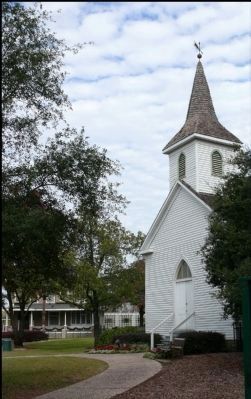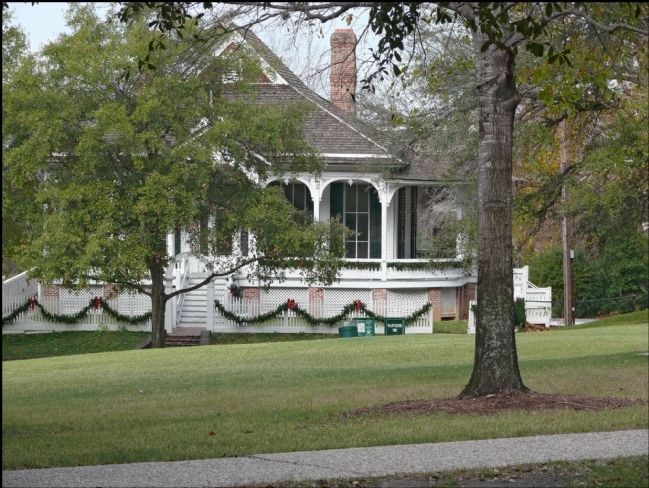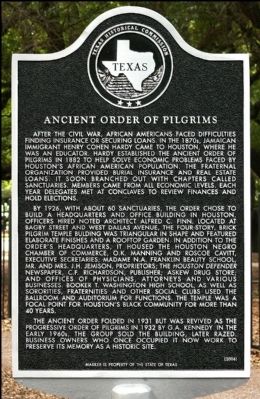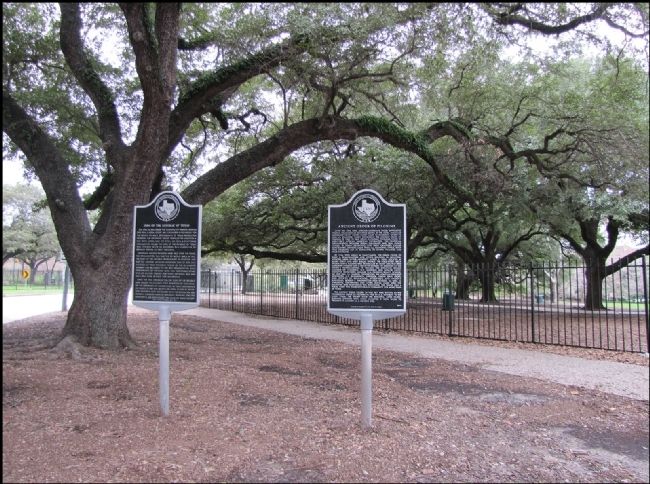Downtown Houston in Harris County, Texas — The American South (West South Central)
Ancient Order of Pilgrims
By 1926, with about 60 sanctuaries, the order chose to build a headquarters and office building in Houston. Officers hired noted architect Alfred C. Finn. Located at Bagby Street and West Dallas Avenue, the four-story, brick Pilgrim Temple Building was triangular in shape and featured elaborate finishes and a rooftop garden. In addition to the order's headquarters, it housed the Houston Negro Chamber of Commerce, O.K. Manning and Roscoe Cavitt, executive secretaries; Madame N.A. Franklin Beauty School, Mr. and Mrs. J.H. Jemison, proprietors; the Houston Defender newspaper, C.F. Richardson, publisher; Askew Drug Store; and offices of physicians, attorneys and various businesses. Booker T. Washington High School, as well as sororities, fraternities and other social clubs used the ballroom and auditorium for functions. The temple was a focal point for Houston's black community for more than 40 years.
The Ancient Order folded in 1931 but was revived as the Progressive Order of Pilgrims in 1932 by G.A. Kennedy. In the early 1960s, the group sold the building, later razed. Business owners who once occupied it now work to preserve its memory as a historic site.
Erected 2005 by Texas Historical Commission. (Marker Number 13313.)
Topics. This historical marker is listed in these topic lists: African Americans • Industry & Commerce. A significant historical year for this entry is 1882.
Location. 29° 45.579′ N, 95° 22.306′ W. Marker is in Houston, Texas, in Harris County. It is in Downtown Houston. Marker is on Lamar Street, 0.1 miles west of Bagby Street, on the right when traveling west. Touch for map. Marker is in this post office area: Houston TX 77002, United States of America. Touch for directions.
Other nearby markers. At least 8 other markers are within walking distance of this marker. Sons of the Republic of Texas (here, next to this marker); Alexander Hodge (within shouting distance of this marker); Nichols-Rice-Cherry House (within shouting distance of this marker); World War I Monument (within shouting distance of this marker); Kellum-Noble House (about 300 feet away,
measured in a direct line); Sam Houston Park (about 300 feet away); The Spirit of the Confederacy (about 300 feet away); Pillot House (about 400 feet away). Touch for a list and map of all markers in Houston.
Also see . . . Pilgrim Temple. (Submitted on January 2, 2013, by Jim Evans of Houston, Texas.)

Photographed By Jim Evans, December 30, 2012
3. Historic St. John's Church and Staiti House in distance
The 1891 St. John Church was built by German farmers in northwest Harris County for their Evangelical Lutheran congregation. The church is a vernacular interpretation of the Gothic Revival style of architecture from the 19th century. Elements of the Gothic Revival style are evident in the church’s arched windows and shutters. The structure was moved from its original site on Mangum Road to Sam Houston Park in 1968. The handmade cypress plank pews in the interior attest to the “can do” spirit that built this elegantly simple place of worship.

Photographed By Jim Evans, December 30, 2012
4. Historic Pillot House
The 1868 Pillot House was built by Eugene Pillot and was originally located at 1803 McKinney. This house is an example of the Eastlake Victorian style. The repetitive balusters and two dimensional cut-out ornamentation seen on the house were made possible by new machinery of the time period. Architectural enhancements such as full-length windows and wrap-around porches illustrate how residences were adapted to the harsh climate of Houston.
Credits. This page was last revised on February 1, 2023. It was originally submitted on January 2, 2013, by Jim Evans of Houston, Texas. This page has been viewed 1,060 times since then and 66 times this year. Photos: 1, 2, 3, 4. submitted on January 2, 2013, by Jim Evans of Houston, Texas. • Bill Pfingsten was the editor who published this page.

